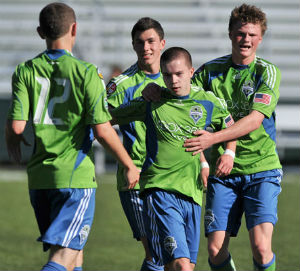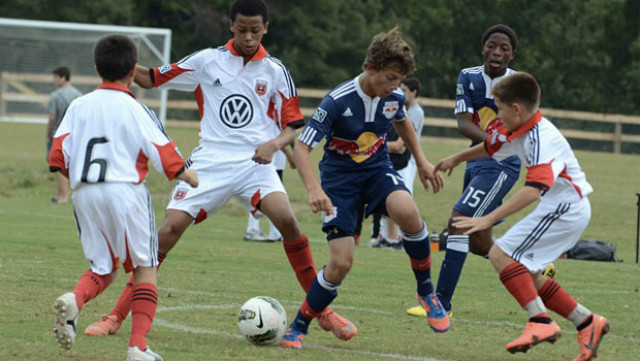 A Rave Green generation?
A Rave Green generation?MLS Academy coaches reflect on challenges

Since the program’s inception a little more than five years ago, more than 70 players have joined Major League Soccer via the Homegrown rule, coming through an MLS Academy before signing a pro deal.
And while a much smaller fraction of that group has enjoyed early success in MLS, the initiative for the league is still very young, with most academies no more than the same age as the rule itself.
 A Rave Green generation?
A Rave Green generation?That notion isn’t lost on the coaches leading the charge at various MLS Academies.
“We’re off to a good start, but we’re in the grassroots of this in the United States, most of the Academies have only been going 5-6 years,” Sporting KC Academy Director Jon Parry told TopDrawerSoccer.com. “We’ve got a long way to go, and every market is different.”
No more was that more evident than during the recent trip MLS Academy officials took to Europe as part of a new licensing program aimed at improving development here in the United States.
That time, while incredibly helpful, also gave coaches a chance to reflect on the differences in approaches to player development, and what improvements the league needs to make regarding their academies.
“My biggest takeaway [from the trip] was the emphasis that they put on developing creative players that can solve problems, that can find solutions within a game,” D.C. United U18 head coach Nolan Sheldon told TopDrawerSoccer.com. “That would probably be the biggest thing, and then their curriculum and training methodology is set up to promote that.”
Patience in figuring out the right formula was also another common theme, as nothing is going to happen overnight, especially when comparing MLS clubs with European counterparts, which have existed and developed players far longer than teams in the United States.
It also takes a certain amount of patience when talking about changing an approach to developing individuals.
“One of the takeaways is that it also takes a long time,” Sheldon said. “And we as coaches in the United States we’ve got to be patient to allow that process for that to play out, for a kid that’s 10, 11, 12, 13, into 14, 15 years old, we’ve got to be patient and help the player discover solutions rather than providing solutions to the player.”
Then of course, there is the whole winning vs. development argument, something that is not lost on these coaches.
“We talk about worrying about players only here but this is a results-based culture,” Sounders Academy Director Darren Sawatzky told TopDrawerSoccer.com. “We have nine year olds winning state championships – the point is there has to be a balance because you’re not going to take that completely out of the American psyche but you’ve also got to look at it and say what’s the science that’s proven over there to develop world-class players. We still need to work on our development of our players in this country.”
Perhaps the most noticeable or immediate gap the trip reinforced is what players do from 18 to 22 years old. In the United States, college soccer is an option that many seek, but when trying to develop world-class players, it offers limited training time. For Houston Dynamo Academy Director James Clarkson, finding a place for that age group is the biggest challenge MLS faces at the moment.
“When you spend time at a professional club in Europe, you see they have a U19 team, they have a reserve team, these players have opportunities to train consistently every day, play in reserve leagues, train and learn to be a pro, that’s where I feel the biggest gap is,” he said. “We looked at all of the age groups at Lyon, the 9s, 10s, 11s, 13s, 14s, 15s and really it’s all very similar. More better players, but the four of us there were there all felt we had players within those age groups that could slot in there quite comfortably. But when they get to 18 it just seems to go to another level.”
Right now, all MLS has is a ten-game reserve league season, although this year launched an initiative with United Soccer Leagues in order to try and offer playing time for younger players at a relatively high level. Until that is sorted, the path from a U18 Academy team to the pro ranks is muddled – not to mention the fact that a player would almost likely be signing a contract worth far less than the chance of scholarship money at a prominent college (if available, of course).
The trip to Europe also highlighted a couple of other important directions Academies need to go – one being the need to instill a sense of loyalty to the local team at a young age.
“We’ve had an incredible experience in Seattle with the start of the MLS team here and we can see a whole generation of kids already that are Rave Green kids,” Sawatzky said. “And using our area as an example, if you can get the people in your area to buy into that’s their team, and that’s it, it’s all or nothing, you’re going to create a loyalty that when a kid is five years old, by the time that they are 18, there is just no other place they want to be. That’s a valuable asset for a club.”
Continuity within the youth ranks is another that Clarkson noticed – magnified of course by what he’s seen at his home club.
“When I look at the Dynamo, I think one of the reasons for the Dynamo’s success is [head coach] Dominic [Kinnear] has been there for seven years,” he said. “It’s that consistency, not chopping and changing coaches, there’s a real philosophy within the club. And then I think at the youth level that definitely has to be there or else we’ll just be bouncing around trying to re-invent the wheel every other year.”
There is still work to be done in many areas in MLS, but the resources are slowly being diverted – this recent trip to Europe included. Don Garber also indicated that in 2012 alone, the league spent $20 million on youth development, though without getting into specific details on what that entails.
Whether or not the efforts pay off in the long run may take at least another decade or two to know for sure.
Headlines
- Recruiting Roundup: August 11-17
- 2025 College Soccer Preview Content
- How Do I Get Scouted by TopDrawerSoccer?
-
CAA, Big West, MAAC, Patriot Preview

- TDS Men's Player of the Year History
- ECNL Girls Announces 2024-25 Awards
-
Men's Horizon, OVC, MVC, SoCon Preview

-
Men's AAC, ASUN & Big South Preview

-
Commitments: NJ Defender Picks Rutgers

- NCFC Youth Elevates Officials at Tournament



